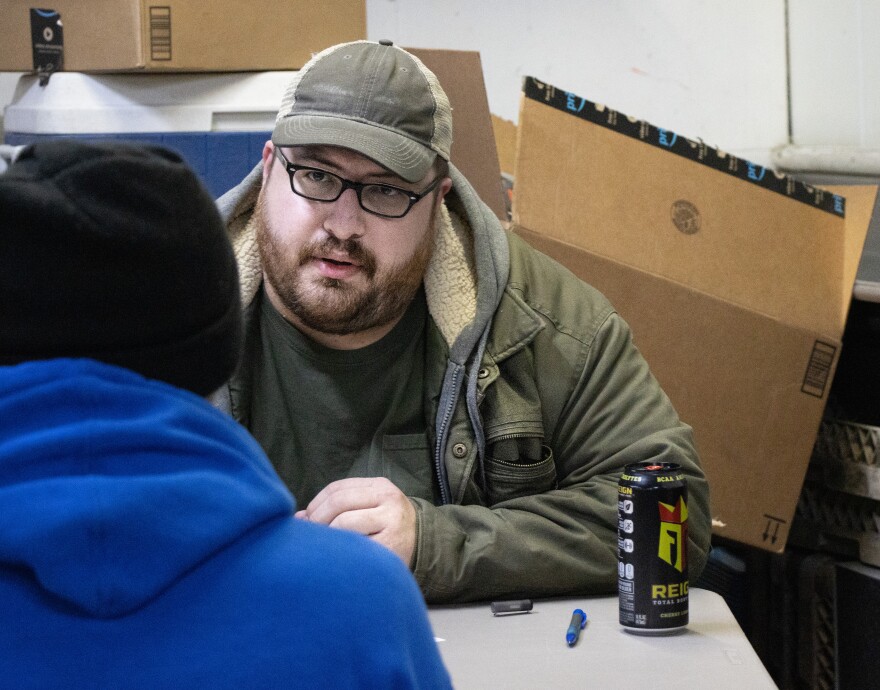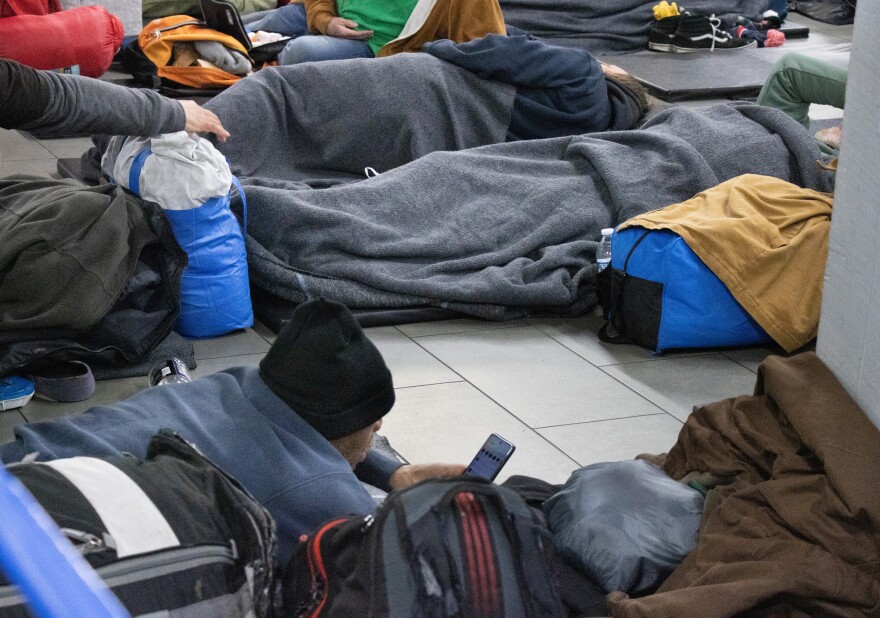
It’s a frigid late January morning and an outreach team is looking for people camping outside as part of the annual winter Point In Time (PIT) homeless count.
They’re walking along train tracks in north east Evansville, limestone crunching underfoot. They’re looking for a known camp used by at least a few people most of the time — even in late January.
Natasha Goodge with Aurora Evansville is leading this group — to not only learn about the homeless, but to also offer services. They carry free backpacks, snacks and hand warmers with them.
Aurora, the non-profit organization which aims to prevent homelessness in Evansville and beyond, is in charge of this region's annual count of those experiencing Category One homelessness, through the Department of Housing and Urban Development (HUD.)
Category One means they’re either living on the street, in a homeless shelter or somewhere unfit for habitation.
The count group includes Ivy tech intern Christa Thomas and Kaylee Schaberts Systems Navigator with the Indiana Housing and Community Development Authority (IHCDA.)
The IHCDA will receive the preliminary results from Aurora once everything is compiled, and release official numbers in the summer.
As they nearly reach the camp, Goodge calls out to anyone who might be inside.
“Outreach!” she said. “Hey, everybody around?”
This camp created by homeless individuals, is tucked into a small triangle of woods flanked by train tracks and a service road. Clothing is perched on branches, bobbing in the wind. Aluminum cans are sorted into crushed and uncrushed piles. Ice slides from the tarp covering the larger tent.
Goodge sticks her head inside. “Is anybody home?”
This particular morning no one is here. Goodge said they might be at a day shelter or maybe the library. This morning they’ve found 10 individuals so far.
While they do drive around to known spots people might be staying, the most efficient way to count is when clients arrive at the United Caring Shelter at night to sleep.

Goodge also leads the count at the United Caring Shelter in Evansville, which is open every night this winter.
“My name is Tasha. I work for Aurora,” she says to guests as they enter, bags in hand. “Do you know about Aurora? Would you be interested in completing a point in time survey today?”
Asking is a tough sell — many are nervous about sharing their demographic information, and media present might not help either.
But if they agree, they’ll talk to some Aurora staffers at a table in the back.
“Have you had experience with alcohol disorder,” asked Jesse Vanhooser with Aurora, of a client who agreed to answer the questionnaires. He’s seated beside volunteer Daniel Bell.
“So the standard questions on the point in time survey include barriers that people face,” said Vanhooser. “Like if they've experienced substance use disorders, mental health conditions, if these conditions are a barrier to housing for them. It also includes length of time homeless, phrased in a couple different ways. Like, when was the last time you had somewhere to sleep that was not an emergency shelter.”
The shelter is at capacity, so they’ll count 52 people. Vanhooser organizes his finished questionnaires which include age and veterans and disability status.
After an hour or so, final smokes happen, and everyone settles in on their gym mat to go to sleep.

Once complete, everything including data from regional partners were compiled, and the preliminary count is now out.
“After two years of pretty significant decline and identifying category one homeless here in our community, we saw a pretty significant increase,” said Aurora Executive director Zac Heronemus.
The IHCDA region 12 grew from 355 to more than 500. “And that's, you know, not a good sign," he said.
Region 12 includes Daviess, Dubois, Perry, Spencer, Warrick, Vanderburgh, Posey, Gibson, Pike and Knox counties. The concentration is in the City of Evansville.
They’re still investigating why, but Heronemus attributes this to the end of COVID-era programs which prevented evictions. Combine that with raising home and rent prices, and you’ve got an increase locally and beyond.
Leslie Townsend Cronin is executive director for the Homeless Coalition of Southern Indiana, which services counties in southeast Indiana. Their count increased by 80 up to 269. They cover region 13, which includes Orange, Washington, Scott, Jefferson, Clark, Floyd, Harrison and Crawford counties.
“I think that these prevention dollars kind of put up a temporary dam,” she said. “And that temporary dam is now broken. And so a lot of people that may have been behind that dam, no longer have those, you know, kind of kind of have that there.”
Townsend Cronin also acknowledges the challenge with the count itself. It’s not possible to find everyone, and some individuals can’t be counted. If they’re in a hotel for the night because someone put them up, they don’t count as being Category One homeless.
She thinks the key is more affordable housing, and Heronemus agrees.
At the PIT count at the shelter, Vanhooser and Goodge said "affordable housing" kept coming up more than impacts of drugs and alcohol. Still, elevated drug use and poverty in the city is also a factor.
There are signs of hope, however.
Heronemus mentioned mixed and affordable income apartment complexes such as The Forge on Main and the coming Baker Street Flats and Promise Home by Echo Housing.
Townsend Cronin says more cities are making affordable housing a priority as the challenge of homelessness is recognized. She also hopes eviction prevention dollars can be codified into law.
While Heronemus was not surprised by the high count — he was definitely unhappy.
“To say that we weren't disappointed, would not be the truth,” he said. “We were disappointed. And we know we've got a lot of work to do. Not just us, but our partners in service and, you know, we use this Point In Time number as a baseline — who is out there, in the street or in shelters or on the street at any given night.”
The IHCDA will vet the preliminary numbers, usually by July — right around the time Aurora will conduct a summer time count on their own.
Music in audio story by The Passion HiFi

